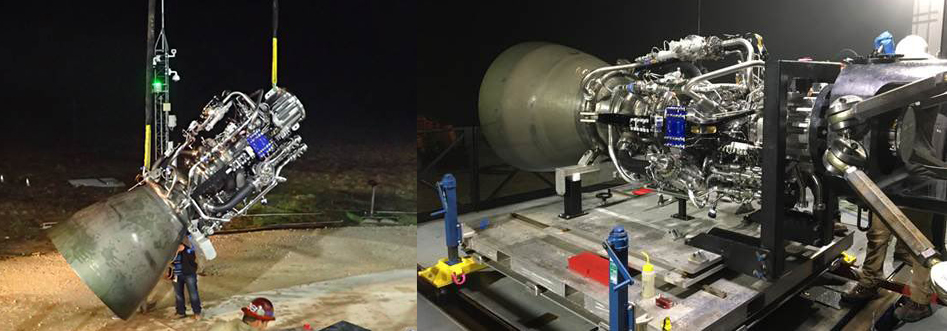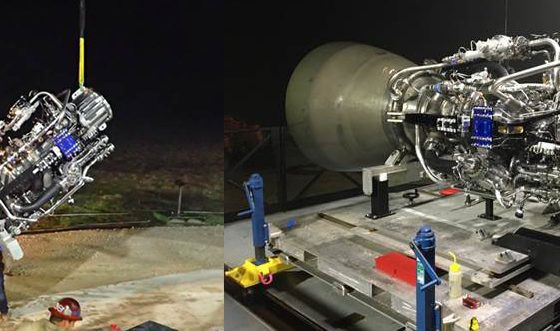

News
SpaceX CEO Elon Musk reveals photos of Starship’s first completed Raptor engine
Shortly after Teslarati reported that the first operationalized Raptor had shipped to McGregor, Texas for its first full-scale static fire tests, SpaceX CEO Elon Musk took to Twitter to post the first official photos of the “radically redesigned” engine preparing for its critical debut test fire in Texas.
Designed with extreme reliability, efficiency, and reusability in mind, the Raptor seen in Musk’s photos is rated for just shy of 2.5 times the thrust of Merlin 1D at 200 tons (450,000 lbf) and has been commonized across both stages of BFR (Starship and Super Heavy) to spread out development costs and speed up the next-generation rocket’s orbital launch debut.
Preparing to fire the Starship Raptor engine at @SpaceX Texas pic.twitter.com/8JCOi1BG6z
— Elon Musk (@elonmusk) February 1, 2019
Aside from revealing some impressive photos of the first upgraded Raptor preparing for a static fire test, Musk went into a bit more detail on the future of the engine and its probable development path, describing Raptor in its current iteration as a sort of compromise between achieving nominal performance and minimizing the cost and timescale to arrive at a flight-ready engine. Currently stationed at SpaceX’s McGregor, Texas development and testing facilities, Raptor appears to feature an expansion ratio somewhere in between Merlin 1D (optimized for sea-level) and MVac (optimized for vacuum).
Initially making one 200 metric ton thrust engine common across ship & booster to reach the moon as fast as possible. Next versions will split to vacuum-optimized (380+ sec Isp) & sea-level thrust optimized (~250 ton).
— Elon Musk (@elonmusk) February 1, 2019
This increases the stress on the nozzle during ignition and operation at normal atmospheric pressures but it also improves engine efficiency once Starship (or Super Heavy) rises above the thickest parts of Earth’s atmosphere, even if a medium-expansion nozzle still can’t touch the performance of a giant vacuum-optimized bell like those used by MVac. As such, BFR in its earliest iterations will be significantly less capable than a fully-optimized version of the rocket when it comes to high-energy Earth/lunar orbits and interplanetary trajectories, a challenge that can at least initially be hurdled by accepting much lower nominal payload capabilities and relying on brute-force performance, much like Falcon 9 and Heavy.

Assuming the first hot-fire tests of the full-scale, operationalized Raptors go well, three of the next-gen engines could support the first hop tests of a full-scale Starship prototype sometime in the next few months, potentially as early as late-February or March. Musk also reiterated that Starship’s complimentary booster – known as Super Heavy and set to begin initial prototype assembly as early as April – will feature 31 Raptor engines capable of producing upwards of 12.4 million pounds of thrust (62,000 kN) at liftoff. However, Musk indicated that the sheer value of 31 advanced Raptor engines also means that the first Super Heavy flights may only feature a partial complement of engines in case the vast booster experiences a failure, far from uncommon during the first few launches of a new rocket.

News
Tesla FSD fleet is nearing 7 billion total miles, including 2.5 billion city miles
As can be seen on Tesla’s official FSD webpage, vehicles equipped with the system have now navigated over 6.99 billion miles.

Tesla’s Full Self-Driving (Supervised) fleet is closing in on almost 7 billion total miles driven, as per data posted by the company on its official FSD webpage.
These figures hint at the massive scale of data fueling Tesla’s rapid FSD improvements, which have been quite notable as of late.
FSD mileage milestones
As can be seen on Tesla’s official FSD webpage, vehicles equipped with the system have now navigated over 6.99 billion miles. Tesla owner and avid FSD tester Whole Mars Catalog also shared a screenshot indicating that from the nearly 7 billion miles traveled by the FSD fleet, more than 2.5 billion miles were driven inside cities.
City miles are particularly valuable for complex urban scenarios like unprotected turns, pedestrian interactions, and traffic lights. This is also the difference-maker for FSD, as only complex solutions, such as Waymo’s self-driving taxis, operate similarly on inner-city streets. And even then, incidents such as the San Francisco blackouts have proven challenging for sensor-rich vehicles like Waymos.
Tesla’s data edge
Tesla has a number of advantages in the autonomous vehicle sector, one of which is the size of its fleet and the number of vehicles training FSD on real-world roads. Tesla’s nearly 7 billion FSD miles then allow the company to roll out updates that make its vehicles behave like they are being driven by experienced drivers, even if they are operating on their own.
So notable are Tesla’s improvements to FSD that NVIDIA Director of Robotics Jim Fan, after experiencing FSD v14, noted that the system is the first AI that passes what he described as a “Physical Turing Test.”
“Despite knowing exactly how robot learning works, I still find it magical watching the steering wheel turn by itself. First it feels surreal, next it becomes routine. Then, like the smartphone, taking it away actively hurts. This is how humanity gets rewired and glued to god-like technologies,” Fan wrote in a post on X.
News
Tesla starts showing how FSD will change lives in Europe
Local officials tested the system on narrow country roads and were impressed by FSD’s smooth, human-like driving, with some calling the service a game-changer for everyday life in areas that are far from urban centers.

Tesla has launched Europe’s first public shuttle service using Full Self-Driving (Supervised) in the rural Eifelkreis Bitburg-Prüm region of Germany, demonstrating how the technology can restore independence and mobility for people who struggle with limited transport options.
Local officials tested the system on narrow country roads and were impressed by FSD’s smooth, human-like driving, with some calling the service a game-changer for everyday life in areas that are far from urban centers.
Officials see real impact on rural residents
Arzfeld Mayor Johannes Kuhl and District Administrator Andreas Kruppert personally tested the Tesla shuttle service. This allowed them to see just how well FSD navigated winding lanes and rural roads confidently. Kruppert said, “Autonomous driving sounds like science fiction to many, but we simply see here that it works totally well in rural regions too.” Kuhl, for his part, also noted that FSD “feels like a very experienced driver.”
The pilot complements the area’s “Citizen Bus” program, which provides on-demand rides for elderly residents who can no longer drive themselves. Tesla Europe shared a video of a demonstration of the service, highlighting how FSD gives people their freedom back, even in places where public transport is not as prevalent.
What the Ministry for Economic Affairs and Transport says
Rhineland-Palatinate’s Minister Daniela Schmitt supported the project, praising the collaboration that made this “first of its kind in Europe” possible. As per the ministry, the rural rollout for the service shows FSD’s potential beyond major cities, and it delivers tangible benefits like grocery runs, doctor visits, and social connections for isolated residents.
“Reliable and flexible mobility is especially vital in rural areas. With the launch of a shuttle service using self-driving vehicles (FSD supervised) by Tesla in the Eifelkreis Bitburg-Prüm, an innovative pilot project is now getting underway that complements local community bus services. It is the first project of its kind in Europe.
“The result is a real gain for rural mobility: greater accessibility, more flexibility and tangible benefits for everyday life. A strong signal for innovation, cooperation and future-oriented mobility beyond urban centers,” the ministry wrote in a LinkedIn post.
News
Tesla China quietly posts Robotaxi-related job listing
Tesla China is currently seeking a Low Voltage Electrical Engineer to work on circuit board design for the company’s autonomous vehicles.

Tesla has posted a new job listing in Shanghai explicitly tied to its Robotaxi program, fueling speculation that the company is preparing to launch its dedicated autonomous ride-hailing service in China.
As noted in the listing, Tesla China is currently seeking a Low Voltage Electrical Engineer to work on circuit board design for the company’s autonomous vehicles.
Robotaxi-specific role
The listing, which was shared on social media platform X by industry watcher @tslaming, suggested that Tesla China is looking to fill the role urgently. The job listing itself specifically mentions that the person hired for the role will be working on the Low Voltage Hardware team, which would design the circuit boards that would serve as the nervous system of the Robotaxi.
Key tasks for the role, as indicated in the job listing, include collaboration with PCB layout, firmware, mechanical, program management, and validation teams, among other responsibilities. The role is based in Shanghai.
China Robotaxi launch
China represents a massive potential market for robotaxis, with its dense urban centers and supportive policies in select cities. Tesla has limited permission to roll out FSD in the country, though despite this, its vehicles have been hailed as among the best in the market when it comes to autonomous features. So far, at least, it appears that China supports Tesla’s FSD and Robotaxi rollout.
This was hinted at in November, when Tesla brought the Cybercab to the 8th China International Import Expo (CIIE) in Shanghai, marking the first time that the autonomous two-seater was brought to the Asia-Pacific region. The vehicle, despite not having a release date in China, received a significant amount of interest among the event’s attendees.








